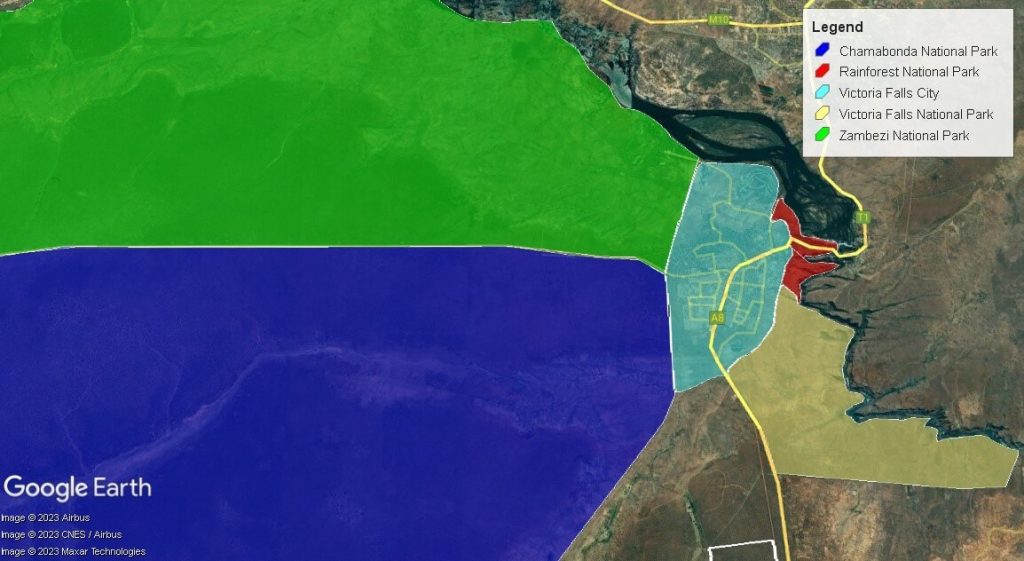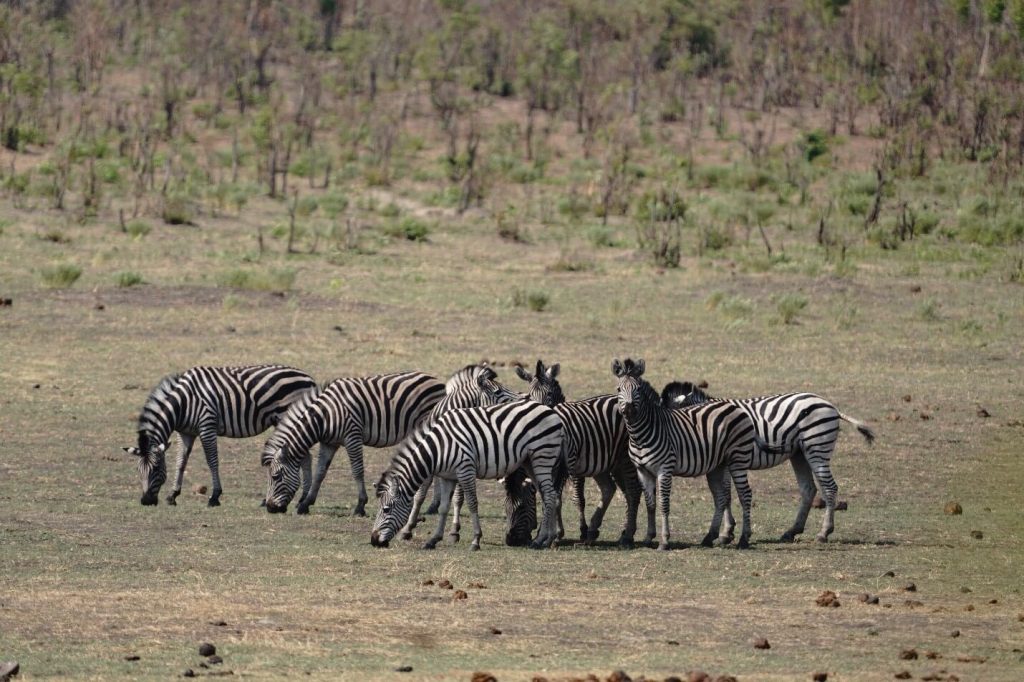Victoria Falls National Park is one of the most unique National Parks on Earth. Not only does it house one of the World’s largest waterfalls, but also has an entire city located within its borders. Whilst the whole area is considered the Victoria Falls National Park, it is divided into 4 distinct parks, each with their own names and serving their own purposes. Whilst all sections of the Victoria Falls National Parks can be visited by the public, some are privately owned with luxury camps whilst others have time restrictions.
Where ever you go within the Victoria Falls National Parks, one thing is for certain. This is the animal’s home, and we are visitors to their area. Whether you are on a safari drive, a luxury boat cruise, touring the might waterfall or simply walking around town, animals have the right of way, and you certainly need to have your wits about you.
The map extract below illustrates the divisions that make up the Victoria Falls National Parks

Chamabonda Vlei- The Sea of Grass
This section of the Victoria Falls National Park is probably the largest section, and very unique in that it does not form the border with another country. Chamabonda, loosely translates as “clap your hands in respect” in the local language. This can only be reference to the vast grass seas which make up much of this areas landscape. Well wooded slopes roll down into a valley lush with open savanna grassland. Home to herds of buffalo, elephants and eland. This is truly the land of giants.
With no natural water occurring year round, the Chamabonda has been well managed with artificial water points established to provide the abundant wildlife with life supporting water for the whole year. By doing so, and in the dry season, this part of the Victoria Falls National Park is a Safari paradise. With animals flocking to the man-made pans. All one needs to do is sit back and watch. It’s not uncommon to have over 100 elephants descend on one water point, desperate to quench their thirst after a hard days foraging.
This also creates ample opportunity for predators to find easy meals. Much like an eager safari goer, all a predator needs to do is relax in the shade near a waterhole and wait for the favorite meal to walk by.

The Chamabonda section of Victoria Falls National Park is open to the public. Guests can either drive themselves or join a commercial game drive. Commercial game drives range from $45 to $80 per person depending on the operator and what extras are included. The main benefit of going with an operator is that they are very familiar with the Park and generally have a great understanding of where to find the animals.
Guests who choose to self-drive will need to ensure that they have settled their parks fees at the main office before venturing through the gates. Fees are $15 per person entrance fee and $5 per vehicle. Whilst this is significantly cheaper than going with a commercial operator, it does mean that you conduct your drive entirely at your own risk. It is essential that you use a vehicle that has 4×4 capabilities as there are areas that one could potentially get stuck.
Zambezi River Drive
This is by far the most scenic part of the Victoria Falls National Park. Not only is it relatively large and abundant with wildlife, but its entire northern boundary is along the banks of the mighty Zambezi River.
This eternally flowing water provides year round sustenance to the vegetation along its banks, meaning even in the dry season its shores look like an oasis against the dusty interior of the park. Water is life, and being one of the largest river systems in Africa, it is an area that wildlife flocks to when times are toughest.
Whilst this river provides life along its banks it is also full of abundant life within its waters. With over 72 species of fish as well as giant Nile crocodiles and the massive hippos there is an entire safari with its waters.
Again, this section of the Victoria Falls National Park is open to the public either on self-driven vehicles or on commercial safari drives. This amazing river can also be explored by boat and is famous for offering one of a kind boat cruises. Taking in a majestic African Sunset whilst cruising the might Zambezi river. Being such a picturesque setting, there are also several luxury lodges nested amounts the trees along the banks. Offering guests the opportunity to fall asleep listening to the grunting of Hippos and the lapping of water.

The Zambezi river section of the Victoria Falls National Park is also very susceptible to seasons and this is very evident in the ups and downs of the river level. Low water is at its lowest in about November, right at the end of the dry season and just before the rains have set in. Here the river surface is broken by thousands of jagged rocks pushing up from the river bed. This provides refuge to many birds and animals crossing or hunting in the river.
Low water also provides one of the only opportunities for animals to cross onto islands for fresh vegetation. With the reduced water level, some islands become part of the mainland again. It is not uncommon for some animals to spend an entire year on an island, crossing when the water was low, but becoming stranded when the water rises.
High water is at its highest in around May, after the seasonal rains, as well as the flood waters from up north at the source of the Zambezi. At this time of year the river is at its most dangerous and very few animals (besides elephants) attempt to cross. The water is usually brown from the multitude of floods that have burst their banks, and the current is incredibly strong.
The river is a thundering monster during these months with the incredible force of water on full display. Many of the activities such as white water rafting and canoeing shut for a time to allow the river to calm down. This usually takes just a couple of weeks before the cycle starts again.
One of the most incredible things about this part of the Victoria Falls National Park is that during high water, over 300,000 gallons of water tumble over the waterfall every second! Whilst there certainly are fluctuations in the river level, it never runs out!
Victoria Falls Waterfall Walk
This is by far the most famous section of the Victoria Falls National Parks, one of the 7 Natural Wonders of the World, and one of the largest Waterfalls. Known in the local language as the “Mosi-au-Tunya”, which literally translates to the “Smoke that Thunders”. A name derived from the constant “smoke” of spray thrown up by the plunging waters, and the continual thunder of the cascading water.
Due to its incredible stature, this section of the Victoria Falls National Park is also a designated UNESCO World Heritage Site. Whilst its land area may be the smallest section of the Park it is by far the busiest, experiencing an average of 400,000 people a year through its gates to marvel at the extraordinary waterfall.

Be prepared to get very wet when visiting this part of the Victoria Falls National Park. With the ever cascading water down into the gorge, it throws up a continual mist of water vapor know as spray. During high water, you can’t even see the Falls in sections as the spray is so dense. There are raincoats for hire at the entrance gate for those that wish to remain dry. Most people however embrace the soaking.
This spray has incredible ecological importance in that its constant presence has established the only true “rainforest” in the area. Your walk through the viewpoints is within the Victoria Falls National Park rainforest. An ever green, lush, bountiful piece of bush that has become a permanent home for a variety of animals and birds. Making your tour of the waterfall a safari at the same time.
Victoria Falls National Park- Private Reserve
The final section of the Victoria Falls National Park is under private management and leased by one of the major operators in the area.
This section is somewhat isolated from the rest of the parks in that it is cut off by the development of the town. As such there was not a lot of wildlife movement within the area.
Over the last several years, the area has been fenced off and had animals introduced. This has created a self-sustaining ecosystem that is supported by a luxury camp and commercial tourism activities. Being privately owned, it is not open to the public. Instead, to visit this area one would need to either book onto one of the activities offered in this park, or stay at one of the lodges within the area.
This section of the Victoria Falls National Park is located below the waterfall and therefore borders against the impressive Batoka gorge in the north. This 300m chasm with its jagged cliffs and turbulent waters below provides incredible scenery.
Besides its breathtaking beauty, the Batoka gorge also plays a very important ecological role for several species of animals. Most notably are the critically endangered Black Eagles, who nest along its cliffs. Being the only section of the Victoria Falls National Park that has this gorge, it is hugely important for the diversity of the ecosystems which this area supports.

The Victoria Falls National Parks combine are some of the most ecologically diverse in the country. From the rolling Kalahari sands, endless grass seas and ancient teak forests in the south, to the mighty Zambezi River, magical waterfall and plunging gorges in the north.
This incredible diversity allows for a wide range of species to thrive with this Park. Whilst it has years of persecution and poaching, it is a Park that is on the rise and every year sightings get better and better.
The Victoria Falls National Parks are also pioneers in a healthy coexistence between animals and humans. With a population of just over 100,000 people living in and amongst some of the most dangerous animals in the world this is a great example mutual respect for nature.
